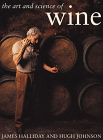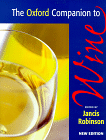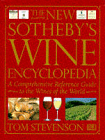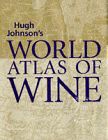
Back to the bookshop front page...
|
James Halliday, Hugh Johnson Mitchell Beazley, London, 1992 (ISBN 1 85732 422 6).
Buy this book from Amazon.co.uk
Patrick Matthews Paperback - 326 pages (20 October, 1997)Faber and Faber; ISBN: 057119043X Reviews wineanorak.com In this book Patrick Matthews sets out to explore the 'ureported wine revolution' as he calls it - the increasing number of small producers who are taking wine back to its regional roots, and in contrast to the legion of bland international-style wines that have flooded our supermarket shelves, are producing wines with real personality and flavour, often at quite reasonable prices. It is a laudable aim, and I for one am fully sympathetic to his cause. Matthews has done his research, he's well informed, and many of the chapters make gripping reading. I especially liked one of the later chapters, 'Cutting out the middle men', which gives a fascinating insight into the machinations of the UK wine trade. The book can also be applauded in that it is pioneering: in contrast to many wine publications it doesn't just go over the same old ground. My main criticism, however, is that The wild bunch feels somewhat unfinished: the writing style is at times quite hard work, and the transition from one subect or chapter to the next is jerky, lacking continuity. The copyediting is pretty poor too (see e.g. the footnote on page 11). If the author had just spent more time re-writing and polishing the book, and had the services of a good editor, I think he could have made it into a classic. As it stands, it is worth reading solely on the basis of the excellent concept and fascinating snippets, even if they are not laced together too carefully. A useful additional feature (which unfortunately will cause the book to date faster) is that each chapter comes complete with a list of recommended wines and their suppliers in the UK, which greatly enhances the utility of the book. A useful addition to any winelovers bookshelf Synopsis The author, Patrick Matthews patrick_matthews@compuserve.com, 29
July, 1999 Buy this book from amazon.co.uk  Confessions of a Wine Lover Confessions of a Wine Lover
Jancis Robinson Paperback - 384 pages ( 5 November, 1998) Reviews Buy this book from amazon.co.uk
Jancis Robinson Paperback - 320 pages ( 2 September, 1999)BBC Consumer Publishing (Books); ISBN: 0563551313 Reviews wineanorak.com Intended as a companion to the BBC TV series, this book actually has little in common with the programmes, which were Jancis' imaginitive and personal snapshots of the different grape varieties, each episode focusing on a different grape by looking at the region that achieves the best with that variety. Instead, the book is a comprehensive introductory wine course that gives the wine novice a thorough grounding in the basics. If this all sounds a little dry, it isn't—Jancis in print is much as she is on telly; witty, sophisticated and eloquent. However, to anyone who has read around the subject of wine a bit, the book covers a lot of familiar ground. An ideal starting point in your reading about wine. Book Information Designed to ensure that you get the most out of every glass, Jancis Robinson's Wine Course covers everything from how to taste and store wine, to deciding what to serve on special occasions, and the best-value bottles to order in restaurants. With an updated vintage guide including the best regions in 1998, choosing your wine has never been more interesting and enjoyable. "She has an encylclopedic grasp of her subject and doesn't put a foot wrong ... a splendid introduction to the world of wine..." -- Stephen Brook, Decanter Magazine Buy this book from amazon.co.uk
Hardcover - 848 pages (21 October, 1999) wineanorak.com (Review of the first edition.) The ultimate wine reference book. Editor Jancis Robinson has called on a large team of some of the most knowledgable wine experts from around the globe to produce over 3000 alphabetically arranged entries covering all manner of wine-related topics. These entries are nicely laid out in a substantial (and weighty) book, which is nicely illustrated by a mixture of line drawings, black and white photographs and a few colour plates. Comprehensive and scholarly, yet at the same time readable enough for leisurely browsing. This is a compulsory purchase for anyone who has a serious interest in wine. The big question for those who own a copy of the first edition is whether it is worth splashing out on the newly released second edition, which has been substantially revised Amazon.co.uk Practically every field of human knowledge seems to have something to contribute. From geology and soil chemistry, through forestry and the nature of the different woods used for barrels and the harvesting of cork bark, to the cultivation of the vine, its training and pruning, and the techniques of fermentation; the list extends even into areas of cutting-edge science such as DNA fingerprinting (which finally in 1997 unravelled the mystery of the parentage of the Cabernet Sauvignon grape--no, wild horses wouldn't drag it from me, you'll have to buy the book). This is not to mention the thorough coverage of wine regions and grape varieties, the role of wine through history and its presence in art, the glossary entries. One could go on and on. This is a stupendous feat of organisation. More than that, it is throughout well written and lively, and in possession of a healthy quantity of attitude. --Robin Davidson Buy this book from amazon.co.ukThe Wine Atlas Oz Clarke Hardcover - 304 pages (12 October, 1995) Reviews www.wineanorak.com A cynic might accuse Oz Clarke and his publishers Websters of blatantly ripping off Hugh Johnson's winning formula. This book follows exactly the format of Johnson's classic 'World atlas of wine', with introductory chapters leading through to an atlas-style survey of the world of wine. However, Websters have given an intruiging twist to their Atlas, by producing a series of beautiful handpainted panoramic vineyard maps of each of the major wine regions, which succeed in bringing to life the various vineyard areas. In addition, Oz Clarke writes well in a lively style, and the layout and accompanying photographs surpass even the high standards set by Johnson's fourth edition. Hugh may have been here first, and both atlases are of a very high standard, but if forced to choose between them, Oz Clarke wins by a whisker. Harvey Steiman, Wine Spectator, 15 December 1995 William Leith, Mail on Sunday, 17 December 1995 Roger Voss, Wine Magazine, February 1996 Book Description Fundamental to the understanding of wine is a sense of place. Knowing which country, which region, which hillside and even which vineyard a wine comes from adds enormously to the pleasure of drinking it. Through its unique cartography and Oz Clarke's lively prose, this revolutionary atlas illustrates and explains the vital connection between the land, the winemaker and his wine and shows how different landscapes as well as the skills of the winemaker contribute to the extraordinary range of flavours found in wine. Synopsis From the Author Initially I wasn't sure I could face writing this huge book, but as soon as my publisher showed me the prototype panoramic map of Chablis, I knew I had to. This is the only wine book that puts you right in the vineyard - and that's where it all begins, in a way what it's all about. And this instant conversion led to 300,000 words of passionate description of the world of wine I love. Buy this book from amazon.co.uk
Oz Clarke Hardcover - 297 pages (14 September, 2000) Reviews Amazon.co.uk One of the most useful portable all-round guides to wines, vintages, producers, grapes and wine regions, Oz Clarke's Pocket Wine Book has always been a fount of down-to-earth wisdom and good sense. The 2001 edition comes along and is no exception. Seasoned punters who have gone the course with Oz will know what to expect--trenchant views, clearly expressed; encyclopaedic knowledge lightly worn; and second-hand access to what is said to be one of the finest noses in Europe. For an expert of his standing, Oz Clarke can be very refreshing at times. (On fizz: "I sometimes think it doesn't matter what it tastes like as long as it's cold enough and there's enough of it".) Ease of use is among the great virtues of this little book: there's no point flicking back and forth among the cross references when you're standing in a crowded supermarket wine department. It's simple to find what you want among the 1,600 entries once the single page of How To Use rules has been absorbed. New sections added for 2001 include a fascinating and highly eclectic selection of personal favourites, and a series of Wines of the Year categories--in effect, Top Tips, such as "World Class Wines that Won't Cost the Earth", "Regions to Watch" and so on. Self-recommending, therefore, as always. --Robin Davidson Buy this book from amazon.co.uk
Robert Parker Hardcover (15 January, 2000) Review of the third edition, wineanorak.com Buy this book from amazon.co.uk
Tom Stevenson Hardcover - 600 pages ( 9 October, 1997) Amazon.co.uk Tom Stevenson's new edition of his Sotheby's Wine Encyclopedia is a formidable achievement. Five years in the preparation (Stevenson had planned for three but found himself overwhelmed by the incredible changes a decade had brought to the world of wine), it is a real master work, putting Stevenson up there among the gurus--Jancis Robinson, Oz Clarke, Hugh Johnson. Genuinely encyclopedic in scope and organisation, this is a publication that delivers what it promises: comprehensive information about all aspects of wine, in a beautifully clear structure and layout. It's wonderfully illustrated, too, with many evocative pictures of vineyards and wineries around the world. As so often with the current crop of all-encompassing blockbuster wine books, the reader is likely to end up bemused by the sheer quantity of information, and the range of disciplines, that the modern wine writer must master. Not so very long ago a few elegant cellar and tasting notes might suffice. These days, the wine writer's skills must encompass geology, geography and soil chemistry; the myriad grape varieties and the best way to train, prune and harvest each of them in different climates; the qualities of the different types of oak used for barrels--French against American against Russian. And that's all before you even start making the wine, let alone tasting it. Tom Stevenson has all this at his fingertips. As a reliable guide for the novice, and an unfailingly informative companion for the connoisseur, The New Sotheby's Wine Encyclopedia will be hard to beat. --Robin Davidson Synopsis Buy this book from amazon.co.uk
Hugh Johnson Hardcover - 320 pages ( 8 September, 1994)
Reviews Synopsis Buy this book from amazon.co.uk |
 The art and science of wine
The art and science of wine The Wild Bunch : Great Wines From Small Producers
The Wild Bunch : Great Wines From Small Producers Jancis Robinson's Wine Course
Jancis Robinson's Wine Course The Oxford Companion
to Wine
The Oxford Companion
to Wine Oz Clarke's Pocket Wine Book 2001
Oz Clarke's Pocket Wine Book 2001
 The New Sotheby's Wine
Encyclopedia
The New Sotheby's Wine
Encyclopedia The World Atlas of Wine
The World Atlas of Wine